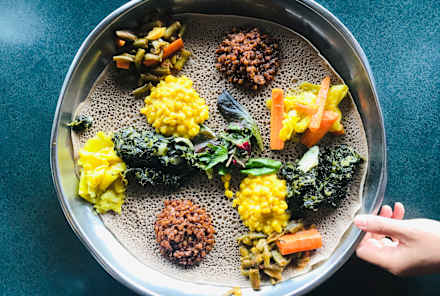Advertisement
16:8 Fasting For Beginners: Pros, Cons, & Sample Meal Plans

Fasting is an ancient practice that’s been used for spiritual and religious purposes for thousands of years. Nowadays, it's the physical benefits of fasting—from blood sugar balance to enhanced energy—that are the buzziest.
There are different types of fasting, but 16:8 is one of the most popular and well-studied. Not only has 16:8 fasting been shown to be effective for improving multiple health outcomes, but it’s less restrictive and easier to follow than other methods (looking at you, 5:2).
In this article, we break down 16:8 fasting and chat with experts about the benefits and possible risks, plus how to get started with a sample meal plan.
The need-to-knows:
- 16:8 is a type of fasting linked with numerous health benefits: 16:8 is a popular and well-studied type of intermittent fasting (IF) that involves restricting your calorie intake to an 8-hour window. It’s been shown to be effective for encouraging weight loss, improving glycemic control, and decreasing heart disease risk factors.
- It’s safe for most people: For most healthy people, 16:8 is safe and isn’t associated with serious side effects. It’s even considered safe for people with health conditions like PCOS.
- When fasting, nutrition and exercise are still key: Be sure to keep up with resistance training and prioritize nutrient-dense foods during your eating window to prevent rapid muscle loss during fasting.
What is 16:8 fasting?
16:8 is one of the most popular types of intermittent fasting (IF)—an umbrella term that includes eating patterns that involve regularly occurring periods of fasting that are longer than a normal overnight fast1.
16:8 is considered time‐restricted eating (TRE), which is one of the major forms of IF. In TRE, calorie intake is restricted to a specific time period2. TRE involves eating as much or as often as you like within a defined period of time, usually between 3 and 12 hours per day, which results in a fasting window of 12 to 21 hours per day.
Using the 16:8 method, you consume all of your calories within an 8-hour window and fast for 16 hours.
“We normally have a daily overnight fast that lasts from 8 to 12 hours and is broken by the 'break-fast' in the morning, so the body is used to daily fasting for some length of time,” explains Kyrin Dunston, MD, FACOG. Engaging in 16:8 fasting prolongs this daily fast to 16 hours.
Because of its relatively generous eating window and lenient rules, 16:8 is one of the most popular fasting methods, especially among newbies.
Benefits of 16:8
In addition to being considered one of the “easiest” forms of IF, 16:8 has been linked to some impressive health benefits, from boosting weight loss3 to improving blood lipid levels4. Here's more on the science behind each:
It could encourage sustainable weight loss
When you limit your eating to a set time period, it usually results in a reduced calorie intake5. This calorie deficit can then promote weight loss.
A 2023 meta-analysis published in Food Science & Nutrition that included eight studies found that the participants who followed 16:8 fasting experienced significant weight loss and fat mass reduction2 compared to control groups.
16:8 fasting can be used with any type of diet, such as low-carb diets and high-protein diets, both of which are effective for promoting weight loss on their own. But, combining a weight loss-promoting diet with 16:8 may be more effective than dieting alone.
A 2022 study that included 169 people found that 16:8 fasting paired with a low-carb diet led to a greater reduction in body weight6 than a low-carb diet or 16:8 fasting alone over a 3-month period. Additionally, only the combination treatment was effective for reducing body weight at month three compared with month two.
Studies also show that IF regimens like 16:8 have a relatively high adherence rate2, meaning that they may be much easier to stick to long-term compared to a more restrictive diet, such as a keto diet or a very low-calorie diet.
It may support healthy blood sugar control in those with diabetes
Research suggests that engaging in IF could be a simple way to improve blood sugar control in people with diabetes.
A 2023 review published in Nutrients concluded that people with type 1 and type 2 diabetes can safely use fasting protocols like 16:8 to improve glycemic control7, reduce body weight, and improve insulin sensitivity.
Study findings suggest that adding just a few days of 16:8 fasting into your weekly schedule could have a major impact on blood sugar control. A 2023 study published in Diabetes Care that included 46 people with type 2 diabetes taking insulin found that the participants who fasted for 18 hours per day for three non-consecutive days per week for three months experienced a significant reduction in the long-term blood sugar control marker hemoglobin A1c (HbA1c) compared with a control group.
Safety note
It may improve cardiovascular health
In addition to benefiting blood sugar control and insulin sensitivity (both of which are essential for a healthy heart), 16:8 fasting may improve heart disease risk factors8 like high levels of blood pressure, LDL cholesterol, and triglycerides.
A 2020 review of 19 studies published in Nutrients found that intermittent fasting protocols, including 16:8 fasting, led to significant reductions in blood pressure9, blood sugar, and triglyceride levels. Other studies have shown that 16:8 fasting can also improve LDL and total cholesterol levels10.
Not to mention, 16:8 can be used as an effective tool to reach and maintain a healthy body weight, which is critical for cardiovascular health.
It could decrease your risk of some diseaseses
Using the 16:8 method may also support overall health by reducing systemic inflammation and stimulating autophagy—a cellular cleansing process by which your cells break down and destroy old, damaged, or abnormal substances. This cellular waste is then used for energy or to make new cellular components.
Because the process of autophagy preserves cellular health11, using practices that trigger autophagy, such as IF, may help support a longer and healthier life.
In fact, "Research suggests that autophagy12 may have a protective effect against aging, cancer, and other diseases," Humaira Jamshed, Ph.D., a nutrition and fasting researcher at the Dhanani School of Science and Engineering, previously told mindbodygreen.
Is 16:8 fasting effective for weight loss?
There’s a reason why many healthcare providers recommend the 16:8 method for weight loss.
A 2020 review that included 27 studies found that fasting regimens, including 16:8 fasting protocols, that lasted for 2 to 26 weeks resulted in weight loss ranging from 0.8% to 13.0% of baseline weight.
A 2023 review of 43 studies showed that people who engaged in IF regimens like 16:8 experienced greater reductions in waist circumference13, body weight, and fat mass compared to other diets, including reduced-calorie diets. The IF regimens were also more effective for maintaining lean body mass compared to the other diets.
Fasting is especially beneficial for promoting belly fat loss, including the loss of visceral fat, a type of deep belly fat linked to increased disease risk. In a 2020 study, adults considered overweight who were randomized to eat within an eight-hour period for 12 weeks experienced an 11.1% average reduction in their visceral fat levels14 compared to their baseline levels.
While more restrictive types of fasting, such as alternate-day fasting (ADF), can also support weight loss, 16:8 is much easier to stick to long-term.
“While more extreme fasting programs can lead to additional weight loss in the short term, they don't typically help establish long-term habits in the same way a more balanced, conservative program can,” Grant Tinsley, PHD, a professor at Texas Tech University and intermittent fasting researcher, previously told mindbodygreen.
One thing to consider if you're looking to use fasting to lose fat is that you'll likely lose muscle in the process too. Muscle mass can negatively impact strength and metabolism15, and having more muscle mass increases the number of calories you burn while at rest. So it's important to continue to build (or at least maintain) your muscle mass through resistance training and a higher-protein diet while fasting. Prioritizing healthy, nutrient-dense foods within your eating window is also key.
And although 16:8 can be an effective way to lose weight, it’s not the only way to reach your body composition goals. Though IF regimens have been shown to result in greater weight loss16 compared to continuous calorie restriction (CCR), others have found no difference17 between the two, meaning both methods can help you lose weight.
Summary
16:8 for women
There’s a decent amount of research supporting the safe use of 16:8 and other TRF fasting methods in women. Many studies have shown that 16:8 can be effective for promoting weight loss, improving blood sugar levels, and supporting other aspects of health18 in women of all ages.
That said, there are a few factors specific to women’s health to consider. For example, unless it’s being used to treat a specific health issue, fasting is generally not advised during pregnancy and breastfeeding. Also, it’s not an appropriate practice for women with eating disorders, like anorexia or bulimia.
Some research also suggests that fasting may not be the best choice for some women over the age of 50, as prolonged fasting periods may negatively impact hormone levels, increase menopausal symptoms like hot flashes19, and worsen balance and lower extremity function. However, there is other research to show that fasting can actually relieve some of the side effects of menopause, so it depends on the person.
Some women may also want to take a break from fasting during the luteal phase of their period, when they tend to be more vulnerable to stress.
Sara Gottfried, MD, a board-certified physician who specializes in women’s health and integrative medicine, explains that intermittent fasting can be especially effective for women with polycystic ovary syndrome (PCOS), a hormonal disorder characterized by cystic ovaries, irregular periods, and excess androgen levels.
A 2021 study20 published in The Journal of Translational Medicine found that women with PCOS who followed a 16:8 fasting regimen for six weeks experienced significant improvements in body weight, insulin resistance, menstrual cycle irregularity, and testosterone levels.
But keep in mind that taking any type of calorie restriction too far can have negative impacts on women's fertility, bone density, and mental health. If you’re interested in fasting, it’s important to ensure you’re supplying your body with enough nutrients as you do.
Summary
Optimizing your feeding window
One of the benefits of 16:8 is that it’s flexible and can be designed to suit your schedule. You can choose when you’d like to schedule your feeding window in the morning or evening.
People who have busier mornings or who like to work out earlier in the day may prefer to schedule their eating window closer to their morning workouts or their start of work, while people who are busier later in the day or who prefer to skip breakfast may benefit from a later eating schedule.
Some research findings suggest that earlier eating schedules may be more beneficial for certain health goals, such as supporting belly fat loss6 and greater overall weight loss21. However, when choosing a feeding window, it’s most important to design a schedule that you can stick to that works for your specific health needs and day-to-day routine.
Sample meal plans
No matter your eating regimen, it’s important to fuel your body with nutritious foods. Though there are no food rules associated with 16:8 fasting, it’s best to choose whole, nutrient-dense foods whenever possible.
Here are sample meal plans for different 16:8 feeding windows:
Early feeding window:
- 8 a.m.: Two-egg omelet made with spinach and cheddar cheese served with sliced avocado and berries
- 12 p.m.: Brown rice and vegetable bowl topped with grilled chicken
- 2 p.m.: Sliced apple and nut butter
- 4 p.m.: Chickpea curry
Later feeding window:
- 12 p.m.: Overnight collagen oats with berries and pumpkin seeds
- 3:30 p.m.: Green protein smoothie
- 5:30 p.m: Fish tacos with cabbage slaw
- 8 p.m.: Turkey burgers with sweet potato fries and a salad
Arguments against 16:8 fasting
Though 16:8 fasting has been linked with several health benefits, not everyone's a fan of the practice. Some people may not like going for extended periods of time with no energy intake or have physically demanding jobs that require a steady supply of calories throughout the day, for example.
It’s also important to point out that if you’re interested in using the 16:8 method to support weight loss or improving other aspects of health like blood sugar but aren’t looking forward to limiting your calorie intake to 8 hours a day, there are plenty of other safe methods you can use to reach your goals. For example, transitioning to a higher-protein diet22 and increasing your activity levels23 are easy ways to enhance blood sugar regulation and encourage fat loss that don’t involve fasting.
Safety & side effects
As long as it’s done in a healthy way, intermittent fasting is considered safe and isn’t associated with many adverse side effects. Keep in mind that 16:8 fasting is considered one of the least restrictive fasting types, as it only involves an 8-hour fast.
Longer fasts, such as fasting regimens that involve fasting for 24 hours, are more likely to cause side effects24 like extreme hunger, headaches, irritability, nausea, fatigue, and lightheadedness. However, people who are sensitive to calorie restriction may also experience these side effects when engaging in shorter fasts, such as 16:8 fasts.
Though 16:8 is generally considered safe, you should always check with your healthcare provider to make sure fasting is the right choice for your specific health needs, especially if you have a medical condition or are taking medications.
The mindbodygreen POV
If you're interested in time-restricted eating, the 16:8 fasting plan is a solid place to start. It's less restrictive than other plans but still has research backing up its benefits for metabolic function and cardiovascular health. 16:8 fasts usually lead to caloric restrictions, and weight loss by extension. To ensure you're not losing too much muscle along with fat, aim to do resistance training and eat plenty of protein on this plan.
—Emma Loewe, mindbodygreen health & sustainability director
Frequently Asked Questions
How long does it take for 16:8 intermittent fasting to work?
This depends on what goal you’re hoping to achieve. For example, 16:8 can encourage changes in body weight and blood sugar levels in a few months, even when you just do it a few times per week. A 2023 study that included 46 people with type 2 diabetes taking insulin found that the participants who fasted for 18 hours per day for three non-consecutive days per week for three months experienced a significant reduction in the long-term blood sugar control marker hemoglobin A1c (HbA1c) compared with a control group.
Is 16:8 fasting the best way to lose weight?
There is no “best” way to lose weight. Even though 16:8 has been shown to be effective for supporting weight loss, the best weight loss method is one that you can stick to and helps you feel your best. If fasting isn’t for you, there are plenty of other weight loss methods you can try, including high-protein diets and low-carb diets.
What are the rules for 16:8 fasting?
The only rule of 16:8 fasting is to fast for 16 hours per day and consume all of your calories within an 8-hour window. Timing and food choices are completely up to you.
The takeaway
16:8 fasting is a type of TRE that involves fasting for 16 hours and eating within an 8-hour window. 16:8 has been linked to a few health benefits, including promoting weight loss and improving blood sugar levels. Because 16:8 involves a shorter fasting window, it’s often recommended to people who are new to fasting and to those who want to reap the benefits of fasting without engaging in very long fasts. Hare are even more tips to help you get started with your first fast.
24 Sources
- https://www.ncbi.nlm.nih.gov/pmc/articles/PMC6520689/
- https://www.ncbi.nlm.nih.gov/pmc/articles/PMC10002957/
- https://www.ncbi.nlm.nih.gov/pmc/articles/PMC5064803
- https://www.ncbi.nlm.nih.gov/pmc/articles/PMC6471315/
- https://www.ncbi.nlm.nih.gov/pmc/articles/PMC8839325/
- https://www.ncbi.nlm.nih.gov/pmc/articles/PMC9589024/
- https://www.ncbi.nlm.nih.gov/pmc/articles/PMC10459496
- https://www.ncbi.nlm.nih.gov/pmc/articles/PMC8558421/
- https://www.ncbi.nlm.nih.gov/pmc/articles/PMC7284632/
- https://www.ncbi.nlm.nih.gov/pmc/articles/PMC10459308/
- https://www.ncbi.nlm.nih.gov/pmc/articles/PMC10509423
- https://www.ncbi.nlm.nih.gov/pmc/articles/PMC6387456/
- https://www.ncbi.nlm.nih.gov/pmc/articles/PMC9108547/
- https://www.ncbi.nlm.nih.gov/pmc/articles/PMC7180107/
- https://www.ncbi.nlm.nih.gov/pmc/articles/PMC5161655
- https://www.ncbi.nlm.nih.gov/pmc/articles/PMC9099935/
- https://pubmed.ncbi.nlm.nih.gov/30475957/
- https://www.ncbi.nlm.nih.gov/pmc/articles/PMC5064803/
- https://www.ncbi.nlm.nih.gov/pmc/articles/PMC2765999/
- https://www.ncbi.nlm.nih.gov/pmc/articles/PMC8045367/
- https://www.ncbi.nlm.nih.gov/pmc/articles/PMC10672223
- https://www.ncbi.nlm.nih.gov/pmc/articles/PMC7539343/
- https://www.ncbi.nlm.nih.gov/pmc/articles/PMC9791347/
- https://www.ncbi.nlm.nih.gov/pmc/articles/PMC6836141/

Why Nutrition Is Key To Changing Your Relationship With Alcohol
Brooke Scheller, DCN, CNS

Why Alcohol Sabotages Your Gut Health & How To Get Back On Track
Brooke Scheller, DCN, CNS

Why Nutrition Is Key To Changing Your Relationship With Alcohol
Brooke Scheller, DCN, CNS

Why Alcohol Sabotages Your Gut Health & How To Get Back On Track
Brooke Scheller, DCN, CNS

Why Nutrition Is Key To Changing Your Relationship With Alcohol
Brooke Scheller, DCN, CNS

Why Alcohol Sabotages Your Gut Health & How To Get Back On Track
Brooke Scheller, DCN, CNS

Why Nutrition Is Key To Changing Your Relationship With Alcohol
Brooke Scheller, DCN, CNS

Why Alcohol Sabotages Your Gut Health & How To Get Back On Track
Brooke Scheller, DCN, CNS














